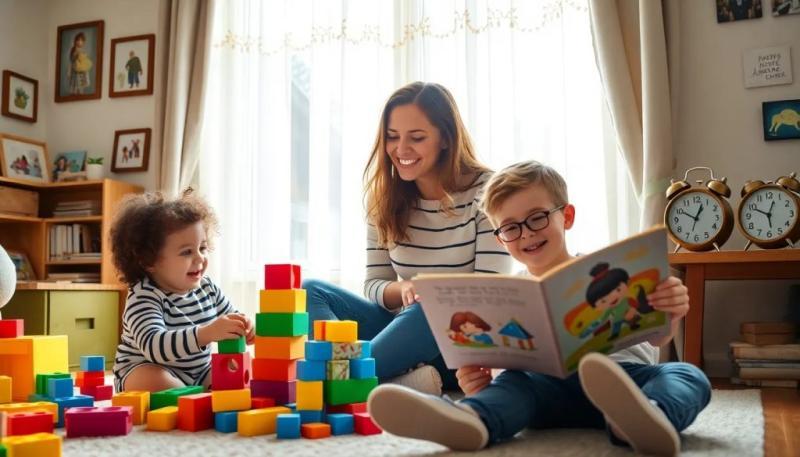Establishing consistent routines is essential for children's growth and development. As families navigate through changes, understanding how babysitters adapt becomes crucial to maintaining a nurturing environment for children. This article explores various strategies that babysitters can implement to ensure stability during transitions.
The importance of establishing consistent routines for children
Children thrive in environments where they know what to expect. A strong routine provides them with a sense of security and helps to reduce anxiety. Establishing a consistent routine fosters emotional, social, and cognitive development. When children have predictable schedules, they are better equipped to manage their emotions and interact positively with others.
A well-defined routine includes structured activities that promote learning and social skills. For example, incorporating time for homework, play, and meals into daily schedules ensures that children engage in a balanced mix of activities. This process supports their adaptability and independence.
Moreover, maintaining routines even when caregivers change is vital. It helps strengthen the parent-child bond and creates a stable environment. Parents can facilitate this by providing babysitters with detailed schedules and clear instructions, ensuring consistency across different caregivers.
How to communicate effectively with your babysitter
Effective communication is a cornerstone of successful babysitting arrangements. Parents should establish open lines of communication with their babysitters from the outset. This includes sharing information about the child's needs, preferences, and routines. Clear communication helps caregivers feel more confident and prepared.
Here are some effective communication tips for babysitters and parents:
- Schedule regular check-ins to discuss any changes in the child's behavior or routine.
- Use a shared digital calendar to keep everyone on the same page regarding schedules.
- Encourage babysitters to ask questions about the child's preferences or routines.
- Provide feedback after babysitting sessions to improve future interactions.
- Develop a communication notebook where babysitters can jot down notes about the child's day.
Incorporating these strategies into your communication can enhance the relationship between parents and babysitters, leading to better care for the children involved.
What strategies help maintain routines across multiple babysitters?
Managing multiple babysitters can be challenging, but with the right strategies, it can lead to a smooth experience for both children and caregivers. One essential strategy is to create a comprehensive care guide that outlines the child's routine, including meal times, nap schedules, and any special instructions.
Another effective approach is to establish a consistent set of rules and expectations that all babysitters must adhere to. This consistency not only helps the children adjust more easily but also fosters trust among caregivers. Here are some key strategies for managing multiple babysitters successfully:
- Implement a color-coded system for scheduling babysitting days.
- Ensure that all caregivers have access to the same information regarding the child's preferences and needs.
- Encourage babysitters to meet each other to discuss shared responsibilities.
- Provide regular updates to babysitters about any changes in the child's routine.
- Establish contingency plans to address unexpected changes or emergencies.
These strategies not only help create a sense of stability for children but also enhance the overall babysitting experience.
How flexibility enhances the babysitting experience
Flexibility is a crucial aspect of effective babysitting. Caregivers must be able to adapt to unexpected changes in schedules or routines. By being flexible, babysitters can respond to the child's immediate needs while still maintaining a sense of structure. This adaptability can significantly enhance the babysitting experience.
For instance, if a child is having a difficult day, a babysitter can adjust the routine to include more playtime or quiet downtime, ensuring the child's emotional needs are met. Additionally, having a flexible approach allows babysitters to incorporate spontaneous learning opportunities, like a trip to the park or an impromptu arts and crafts session.
To foster flexibility, parents should encourage babysitters to think creatively about how to adapt routines. Providing them with options for various activities can also help in this regard. Ultimately, a flexible babysitting arrangement leads to happier children and more satisfied parents.
What to include in a comprehensive caregiver guidebook?
A caregiver guidebook is an essential resource for babysitters, especially when managing changing routines. This guide should include detailed information about the child's daily schedule, preferences, and any specific instructions or rules that need to be followed.
Important elements to include in a caregiver guidebook are:
- Daily routines: Clear outlines of meal times, nap schedules, and playtimes.
- Emergency contacts: Important phone numbers, including parents, relatives, and doctors.
- Behavior management strategies: Tips on how to handle common child behaviors effectively.
- Allergies or medical conditions: Detailed information about any allergies or health concerns.
- Child's interests: A list of activities the child enjoys to facilitate engaging interactions.
Providing this comprehensive guide ensures that babysitters are well-equipped to handle various situations, making the childcare experience smoother for everyone involved.
How to build trust between your babysitter and your child?
Building trust between a babysitter and a child is crucial for a successful caregiving experience. Trust fosters a sense of security and comfort, allowing children to feel safe while their parents are away. Here are some effective strategies to create this bond:
Firstly, parents should introduce the babysitter to the child in a relaxed setting. This can help alleviate any anxiety the child may feel about the new caregiver. Next, encourage babysitters to spend one-on-one time with the child during the first few visits, engaging in play or activities that the child enjoys.
Additionally, consistency plays a vital role in building trust. If a babysitter can maintain the child's routine and follow through on promises, the child will begin to feel more comfortable. Open communication between parents, babysitters, and children can also strengthen trust and understanding.
Overall, fostering trust between babysitters and children enhances the caregiving experience and ensures children's emotional well-being.
Questions related to babysitting routines
What are the three biggest responsibilities of a babysitter?
The three biggest responsibilities of a babysitter include ensuring the safety and well-being of the child, maintaining a structured routine, and providing engaging activities. Safety is paramount; babysitters must be vigilant and prepared to handle any emergencies. In terms of routine, following the established schedule helps children feel secure and understood. Lastly, providing enriching activities encourages healthy development and keeps children engaged during their time together.
What skills are developed from babysitting?
Babysitting can help develop several essential skills, including communication, problem-solving, and responsibility. Effective communication is vital for interacting with both children and parents, ensuring everyone's needs are met. Problem-solving skills are honed through managing various situations, such as handling conflicts or unexpected changes. Additionally, babysitters learn to take responsibility for the care of another person, which boosts their confidence and maturity.
What is the number one rule in babysitting?
The number one rule in babysitting is to prioritize the child's safety at all times. This means being aware of the child's surroundings, understanding potential hazards, and knowing how to respond in emergencies. By keeping safety as the primary focus, babysitters can create a nurturing environment where children feel secure and cared for.
How to make time go faster while babysitting?
To make time go faster while babysitting, caregivers can engage children in fun and interactive activities. Planning a variety of games, crafts, or outdoor adventures can keep children entertained and create a sense of excitement. Additionally, incorporating learning experiences into playtime helps children stay engaged while also developing important skills. By fostering an enjoyable atmosphere, babysitters can transform their time together into a positive and memorable experience.



